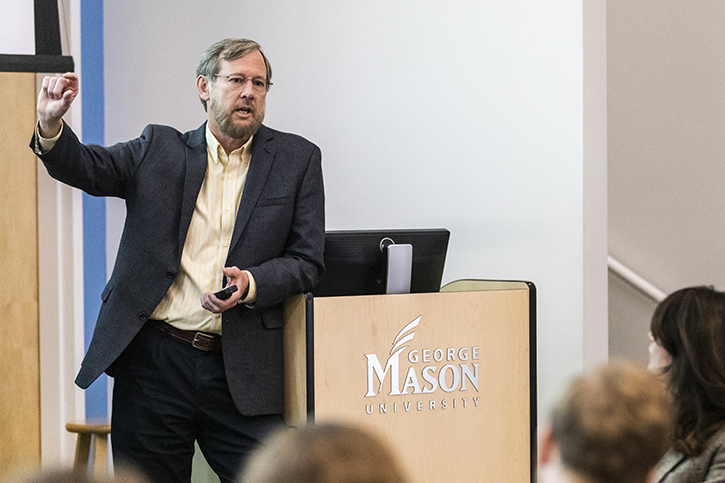
Dr. Karl Hausker, Senior Fellow in the Climate Program at the World Research Institute, discusses the clean energy transition during a lecture at George Mason University. Photo by Lathan Goumas/Strategic Communications
A leading expert on climate change called the problem an “existential threat” to mankind that will require a solution with a two-pronged approach during a talk at George Mason University on Wednesday.
Karl Hausker, a senior fellow in the Climate Program at the World Resources Institute, said that it’s not enough to just reduce the amount of greenhouse gases being released into the atmosphere. Fighting global climate change, he said, will also require the removal of the temperature-spiking carbon dioxide from the atmosphere.
“The good news is that this is still a doable task,” said Hausker, who spoke as part of the 2019 Climate Dynamics Series put on by the Climate Dynamics Doctoral Program and the Center for Ocean-Land-Atmosphere Studies (COLA) within Mason’s College of Science. “New technology will make the task easier and cheaper.”
His comments came in the wake of the proposed Green New Deal, a progressive congressional plan aiming to transform the climate and the economy by ensuring that all energy in the United States comes from “clean” sources without carbon dioxide or methane emissions. The proposed plan would also add jobs in infrastructure development.
Colin Nackerman, a graduate student at Hausker’s talk who has experience working in the solar industry, took particular interest in what Hausker had to say.
“I think it’s great,” he said. “There are a lot of smart people working on these issues to map out our climate and energy future.”
Hausker cited a number of different approaches that can be taken to avoid the 1.5-degree Celsius temperature increase that a United Nations report issued last fall warned would lead to irreparable sea-level rise, species extinction and more bouts of extreme weather that could lead to political upheaval, particularly in developing countries.
Hausker acknowledged the enormous challenges in trying to reduce global emissions of greenhouse gases to zero by 2050, but he said he remains optimistic that a diverse combination of carbon-free energy alternatives—solar, wind, geothermal, electric and nuclear—can meet the goal. The cost of wind power is down 70 percent from 10 years ago, while solar power is 90 percent less costly than it was at that same time, Hausker said, thanks to improved technology and mass production.
“It’s not easy, but it’s doable,” he said. “We need to get serious about turning to these zero-carbon sources.”
Hausker also proposed a combination of carbon capture and sequestration and carbon dioxide removal from the atmosphere. Carbon capture and sequestration is the process of capturing waste carbon dioxide from large sources such as fossil fuel power plants, transporting it to a storage site and depositing it in selected geological rock formations where it will not enter the atmosphere. Carbon dioxide removal is the large-scale removal of carbon dioxide from the atmosphere. Both processes are difficult and costly, but they are necessary additions to the portfolio of solutions because of the intermittency of power generation from renewable sources.
Jim Kinter, the director of COLA and a professor of climate dynamics at Mason, lauded Hausker for expertly laying out the problem while offering realistic solutions.
“By describing the enormity of the problem and simultaneously outlining a strategy to address it, his talk was a call to action,” Kinter said. “I am glad that he is carrying this message to universities like Mason because it is our students who will have to rise to this challenge.”
For more upcoming events in the College of Science’s Department of Atmospheric, Oceanic and Earth Sciences, click here.
